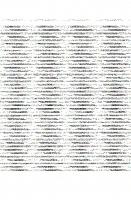Ionic Mobilities in Gaseous Mixtures
428 83 910KB
English Pages 5 Year 1924
Recommend Papers
File loading please wait...
Citation preview
VOL. 10, 1924
PHYSICS: LOEB AND ASHLEY
351
whence Po = 89.7 happens to be exactly- the density of hydrogen. This would fall off about 2.5% on correcting for vapor pressure. Coefficient of Expansion of a Gas. The occurrence of- a static corrective Ax referred temporarily to the surface tension of mercury is surprising. It was therefore determined to test the matter further by measuring the density of air heated to 10QQ 0., or, in other words, to find the coefflcient of expansion. Here, for example, with an eighth inch gas pipe 70 cm. long, surrounded by a steam jacket while the outside air temperature was 270, the slide micrometer showed Ax = 0.0015 cm. Using as above Ax = 0.0006 for the static error Ap = 0.137 (Ax' + 5x) = 288 X 10-6; Ap/At = 3.95 X 10. and (Ap/po)/At = 0.0037, a close approach to the coefficient of expansion, where Ax alone would have given a value of 40% too low. 'Advance note, from a Report to the Carnegie Institution of Washington, D. C. 2 These PROCZZDINGS, 10, 1924, p. 153-5.
IONIC MOBILITIES IN GASEOUS MIXTURES By L. B. LIoB AND M. F. ASHLZY DJPARTMJNT OF PHYSICS, UNIviRSITY OF CALIFORNIA
Communicated June 3, 1924
Since 1909 there have been two rival theories"'56 of the nature of the normal gas ions purporting to describe their behavior. One theory assumes the ion to be a cluster of neutral molecules about a charged molecule, and constitutes the so-called "cluster" ion theory. On this theory the mobility is decreased below that to be expected fo)r a charged' molecule which does not exert forces on the surrounding molecules, because of the decreased mean free path of the large cluster ion. The alternative, or "small ion" theory assumes that the ion is but a single charged molecule whose average free path is decreased by its attractive forces on the surrounding neutral molecules. Many attempts have been made by means of experiments to decide between them with but little success. In 19162. one of the writers performed what he considered a crucial experiment which, while it gave results that appeared to favor the small ion theory was not the experimentum crucis anticipated. With the hope of getting further evidence on this question, the writers set themselves the task of determining ionic mobilities in mixtures of ammonia gas and air. The mobility of the positive ion in NH3 is given as about 0.6 cm./sec. per volt/cm. while that in air,is 1.8 cm./sec. The assumption that this difference in mobility is due to a clustering effect would lead one to expect
352
PHYSICS: LOEB AND ASHLEY
PROe. N. A. S.
the mobility of the ions in air to drop down to a low value for ammonia as soon as appreciable quantities of NH3 were added, provided that the mobility measurements were made in such a manner that the cluster about the ion had time to form. On a small ion theory it might at first sight be assumed that if the decrease in mobility in NH3 were due to some influence of the NH3 molecules on the mean free path of the ions, the mobility would change from that of air to that of ammonia in a linear fashion with the quantity of NH3 present. To investigate this, mobility measurements in dry NH3 and air mixtures were made for positive and negative ions. The Franck3 modification of the Rutherford alternating current method utilizing a square wave form alternating potential from a commutator was employed. The ionization chamber and commutator3 have been described elsewhere. The procedure was to exhaust the ionization chamber to a pressure of less than .001 mm., then to fractionate into it to the required partial pressure NH3 gas which came from a tube containing solid or liquid NH3. Dry air was then admitted to bring the total pressure up to atmospheric pressure. This air was passed through a liquid air trap before it entered the chamber, the air having first been dried by passing through a drying train previously described. Two sources of NH3 were used. The first was a small tank of commercial liquid NH3, the later supply came from a concentrated solution of NaOH acting on chemically pure NH4Cl. The gas was dried by passing through a tube 150 cms. long filled with small granules of NaOH. Before each filling this tube was dried by prolonged pumping with a mercury diffusion pump to a pressure of less than .01 mm. After passing over these tubes the NH3 was condensed out by liquid air. The supply tank was shut off and any traces of air that came over with the gas were pumped out while the NH3 was frozen at liquid air temperature. The liquid air was next removed and the gas distilled into the ionization chamber through two traps cooled to -180C. to remove any traces of water vapor. Care was taken to use only the first three fourths of the liquid NH3 in the tube for a filling, since under these conditions the temperature of the liquid NH3 was quite low and very little moisture was carried over into the ionization chamber. Out of 30 cc. of the liquid NH3 about '/lo of a cc. of water was left in the bulb. The plate distance in the measurements was 1.192 cm. and an alternating potential of about 30 cycles per second was used throughout. The value of the mobility, however, was not changed by changing the frequency, the frequency being kept constant to reduce all possible variables. The results obtained for positive and negative ions plotted as ordinates against the per cent of NH3 present are shown as the circled points and crosses in Fig. 1.* The curves (1) represent the expected linear change for the
VoL. lo, 1924
PHYSICS: LOEB AND ASHLEY
353
small ion theory, while a curve of the type of (2) represents what might be expected on an extreme cluster theory point of view. It is seen that again the results are indecisive. In a paper published in 1917 the writer showed that the mobility of the gaseous ions in different gases followed a modified form of Kaufmann's rule.' This rule states that the mobility of an ion in one gas varies inversely as the square root of the molecular weight of the gas, and in this form it is applicable to the more "perfect" gases only. The writer showed that it was more or less applicable to all gases and vapors if the dielectric
la
Fi
li










